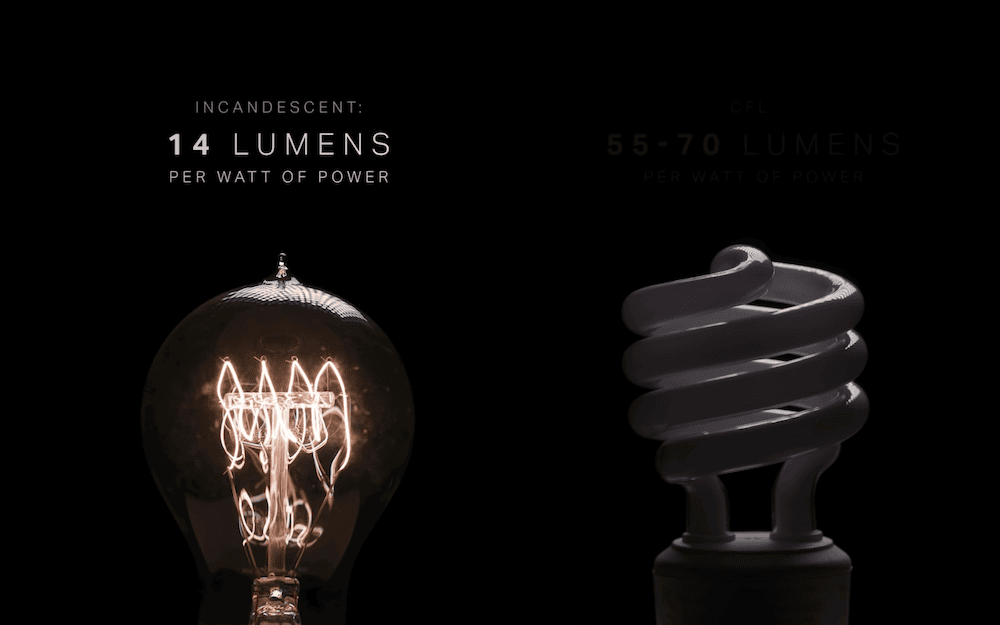
[Image above] Incandescent light bulbs helped launch our exploration of electric light and made possible advances to more efficient technologies. Now, the time to say goodbye to incandescent bulbs draws near. Credit: Verge Science, YouTube
In 2007, the year 2020 was a far-off future to most people. But for light bulb manufacturers, it represented an approaching deadline—the year in which new light bulbs must be 60%–70% more efficient than standard incandescent bulbs.
Energy Independence and Security Act of 2007
The requirement that new light bulbs demonstrate higher efficiency than traditional incandescent bulbs came from the Energy Independence and Security Act (EISA), which former United States president George W. Bush signed on December 19, 2007. The act was meant to move the U.S. toward greater energy independence and security, in part by improving energy efficiency and performance.
The 310-page act contains numerous requirements for a variety of sectors, but in regard to light bulbs, the act outlined two phases of energy efficiency transition:
- Phase one—Common household light bulbs that traditionally use 40–100 watts will use at least 27% less energy by 2014
- Phase two—Most light bulbs must be 60%–70% more efficient than standard incandescents, effective January 1, 2020
Phase one began affecting 100-watt bulbs in January 2012 and ended with 40-watt bulbs in January 2014. In January 2017, the Department of Energy under the Obama administration issued two regulations (here and here) under EISA amendments revising the definitions of general service lamps and general service incandescent lamps to include more types of bulbs.
The Obama-era regulations, in addition to phase two, were supposed to take effect this January. But under the Trump administration, those plans changed.
Trump administration rejects EISA…
In February 2019, the DOE issued a proposal to withdraw the January 2017 regulations, which were subsequently withdrawn in September. In December, the DOE went a step further—they completely rejected adoption of the amended energy conservation standards required in EISA phase two.
…but incandescent bulbs still are on their way out
While rejecting EISA phase two gives incandescent bulbs a little longer lease on life in the U.S., it will likely not be for much longer.
More energy-efficient lighting rapidly replaced traditional incandescent bulbs in the past decade as manufacturers prepared for the expected phase two. U.S. Department of Energy survey data show while 58% of all households used at least one energy-efficient bulb indoors in 2009, 86% of households reported using at least one compact fluorescent (CFL) or LED bulb in 2015. Also, 18% of households in 2015 reported that they had no incandescent bulbs in their homes.
Globally, numerous countries have already phased out or banned incandescent bulbs. For example, all member states of the European Union agreed in 2008 to a progressive phase-out of incandescent light bulbs by 2012 (which was successfully completed); China has banned imports and sales of certain incandescent light bulbs since October 2012. Alongside the bans and phase outs, research on improving energy-efficient lighting, such as cathodoluminescent lamps, actively continues.
For more information on the current U.S. controversy over incandescent bulbs, check out the video below by Verge Science.

Credit: Verge Science, YouTube
Homage to incandescent bulbs
Despite the shortcomings of incandescent light bulbs, these bulbs still helped launch our exploration of electric light and made possible our advances to more efficient technologies.
In homage to incandescent bulbs as they enter their twilight years, check out how these stalwarts of U.S. lighting are manufactured.

Credit: Insider, YouTube
Author
Lisa McDonald
CTT Categories
- Electronics
- Energy
Spotlight Categories
- Member Highlights


